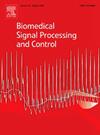基于多尺度金字塔和精确相似度测量的无监督形变配准模型
IF 4.9
2区 医学
Q1 ENGINEERING, BIOMEDICAL
引用次数: 0
摘要
形变配准是医学图像处理中的一个关键问题。由于模态之间纹理模式和强度信息的显著差异,目前的多模态配准算法无法准确提取多模态特征,并且在复杂区域缺乏有效的相似性度量。为了解决这些问题,我们提出了一个多层金字塔大变形多模态配准弹性网络(MPLD)。框架采用全局到局部的注册策略,分为三个阶段:level0和level2阶段(全球注册阶段)和level1阶段(本地注册阶段)。我们提出了一种精确的相似性测量评估器来衡量两幅图像之间的空间差异,该方法将形态学和深度学习相结合,然后通过最小化评估器预测的误差来优化配准。此外,我们提出了一种金字塔多级配准网络(PM-Net),该模块包括两个独立的编码器来提取不同模式的图像特征,并共享同一个解码器,在解码器中使用渐进变形场估计。在公开可用的数据集LPBA40、OASIS和医院临床CT/MR数据上验证了该方法。在临床资料登记中,我们的方法平均DSC为0.816±0.016,平均ASSD为0.894±0.128 mm,平均Std. Jacobian为0.289±0.012。与目前最先进的配准方法相比,我们的算法达到了更高的配准精度。该方法采用由粗到精的渐进变形场预测策略,并利用多尺度特征聚合增强特征提取能力。该方法有效地处理了大变形配准任务,并通过对比实验验证了其优越的配准性能和泛化能力。本文章由计算机程序翻译,如有差异,请以英文原文为准。
Unsupervised deformable registration model based on multi-scale pyramid and accurate similarity measurement
The deformable registration is a critical task in medical image processing. Due to significant differences in texture patterns and intensity information between modalities, current multimodal registration algorithms fail to extract multimodal features accurately and lack effective similarity measures in complex regions. To address these challenges, we propose a multilevel pyramid large deformation multimodality registration elastic network (MPLD). The framework adopts a global-to-local strategy for registration and is divided into three stages: level0 and level2 stage (global registration stage) and level1 stage (local registration stage). We propose an accurate similarity measurement evaluator to measure the spatial difference between two images, this method combines morphological and deep learning, and then optimize registration by minimizing the errors predicted by the evaluator. In addition, we propose a pyramid multi-level registration network (PM-Net), the module includes two independent encoders to extract image features of different modes, and share the same decoder, using progressive deformation field estimation in the decoder. The proposed method was validated on publicly available datasets LPBA40, OASIS, and hospitals clinical CT/MR data. In clinical data registration, our method achieved an average DSC of 0.816 ± 0.016, average ASSD of 0.894 ± 0.128 mm, average Std. Jacobian of 0.289 ± 0.012. Our algorithm achieved a higher registration accuracy compared with state-of-the-art registration methods. This method adopts a coarse-to-fine strategy for progressive deformation field prediction and leverages multi-scale feature aggregation to enhance feature extraction capability. It effectively handles large deformation registration tasks, and comparative experiments confirm the superior registration performance and generalization ability.
求助全文
通过发布文献求助,成功后即可免费获取论文全文。
去求助
来源期刊

Biomedical Signal Processing and Control
工程技术-工程:生物医学
CiteScore
9.80
自引率
13.70%
发文量
822
审稿时长
4 months
期刊介绍:
Biomedical Signal Processing and Control aims to provide a cross-disciplinary international forum for the interchange of information on research in the measurement and analysis of signals and images in clinical medicine and the biological sciences. Emphasis is placed on contributions dealing with the practical, applications-led research on the use of methods and devices in clinical diagnosis, patient monitoring and management.
Biomedical Signal Processing and Control reflects the main areas in which these methods are being used and developed at the interface of both engineering and clinical science. The scope of the journal is defined to include relevant review papers, technical notes, short communications and letters. Tutorial papers and special issues will also be published.
 求助内容:
求助内容: 应助结果提醒方式:
应助结果提醒方式:


